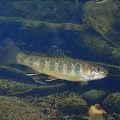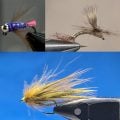How to Tie a Flashback Pheasant Tail
Producer: Tim Flagler
I know there are some of you that will disagree, but I think a beadless, weightless, size 18 Flashback Pheasant Tail nymph is simply a must-have fly, no matter where you fish. I’m never without at least a dozen of them.
For a hook, I’m going to use a Lightning Strike NW3 in size 18. After getting the hook firmly secured in the jaws of my tying vise, I load a bobbin with a spool of brown Veevus 16/0 thread. It’s exceptionally strong and its thin diameter is hard to beat. Get the thread started on the hook shank, leaving a little space behind the eye, and take a few wraps rearward before snipping off the tag.
For the rib of the fly, I like extra-small, copper Ultra wire, a 6” length will make numerous flies. Lay one end of the wire against the near side of the hook and take thread wraps to secure it. Keep taking wraps binding the wire to the near side of the hook, all the way back to the start of the bend.
Natural-colored pheasant tail is used for the tail and abdomen of the fly. Pull down 4 fibers, perpendicular to the stem, and strip them free, while keeping their tips aligned. It’s a good idea to snip off the curlies so they don’t get caught on your tying thread while wrapping. Measure to form a short tail, just slightly greater than a hook gap in length. Anchor the fibers to the top of the hook shank with a few tight turns of tying thread, you can adjust the fibers to length if necessary. Leave your thread right at the base of the tail and start taking touching forward wraps with the pheasant tail behind your tying thread. Pushing up on the thread will help to keep the fibers sandwiched together as you wrap up the shank. Stop wrapping 2/3rds of the way up the shank, and use your tying thread to anchor the fibers. You can then snip the excess off close.
Get hold of the gold Ultra wire and start making open spiral wraps with it up the hook shank, effectively counter wrapping the somewhat delicate pheasant tail fibers beneath. 4-5 turns usually looks pretty good. When you reach your tying thread, loop it around the wire to change the direction of your thread wraps and bind the wire down really well. Once the wire’s secure, again, use it to change the direction of thread wrap. You can then take a few more turns around the hook shank before helicoptering the wire to break it off close.
Large, opal tinsel is used to create the flashback wing case on the fly. As with the wire, a 6” length will make numerous flies. Lay one end of the tinsel against the near side of the hook and start taking wraps of tying thread to secure it. These wraps should push the tinsel to on top of the hook shank. The material is quite slippery, so make sure it’s bound down really well.
Go back to your pheasant tail feather and this time pull down 6 or 8 fibers perpendicular to the stem and strip them free. Once again, snip off the curlies. Flip the fibers around so their tips are pointing to the front of the fly. Measure so about a half a hook shank length of fibers extends beyond the back edge of the hook eye. Take wraps of tying thread to bind the fibers to the top of the shank. When you’re done, snip the excess butt ends off close.
A single strand of peacock herl is used to form the thorax of the fly. Snip an inch or so of its brittle tip off square. Lay the herl against the near side of the hook with the longer, iridescent flues pointing down, and anchor it with wraps of tying thread, ending at the front edge of the abdomen.
As you did earlier with the pheasant tail, make touching wraps with the herl behind your tying thread to ensure each wrap butts tightly against the previous. Leaving a little space behind the hook eye, anchor the herl with wraps of tying thread then snip the excess off close. Preen equal amounts of the pheasant tail tips to either side of the hook to form the legs and take thread wraps to pin them back. This can be a little fussy, just take your time as this step is worth getting right.
When you’re satisfied with the look of the legs, pull the tinsel forward, over top and in front of the hook eye. Take a few wraps of tying thread to anchor the tinsel behind the eye then fold the forward-pointing part of it back and take a few more thread wraps. This will lock the tinsel in place so it can’t pull free. You can then snip the excess tinsel off close.
Now, reach for your whip finish tool and use it to do 4 or 5 turn whip finish, seat the knot well and snip or cut your tying thread free.
Even though this fly is rather small, a drop of head cement, here, Sally Hansen Hard as Nails, applied to the thread wraps will definitely increase durability. If you have a fine-tipped bodkin or even a feather stem, make sure the eye is clear of adhesive.
And that’s a size 18 flashback pheasant tail. Again, I think all fly fishers should carry this pattern in this size. It works that well, that often.
How to Tie a Euro-Style Golden Stonefly Nymph
How to Tie a Flounder Snack











